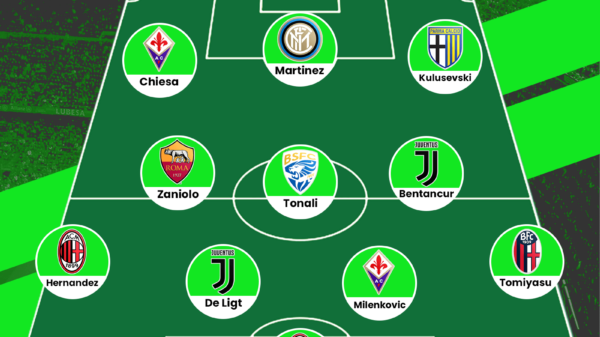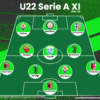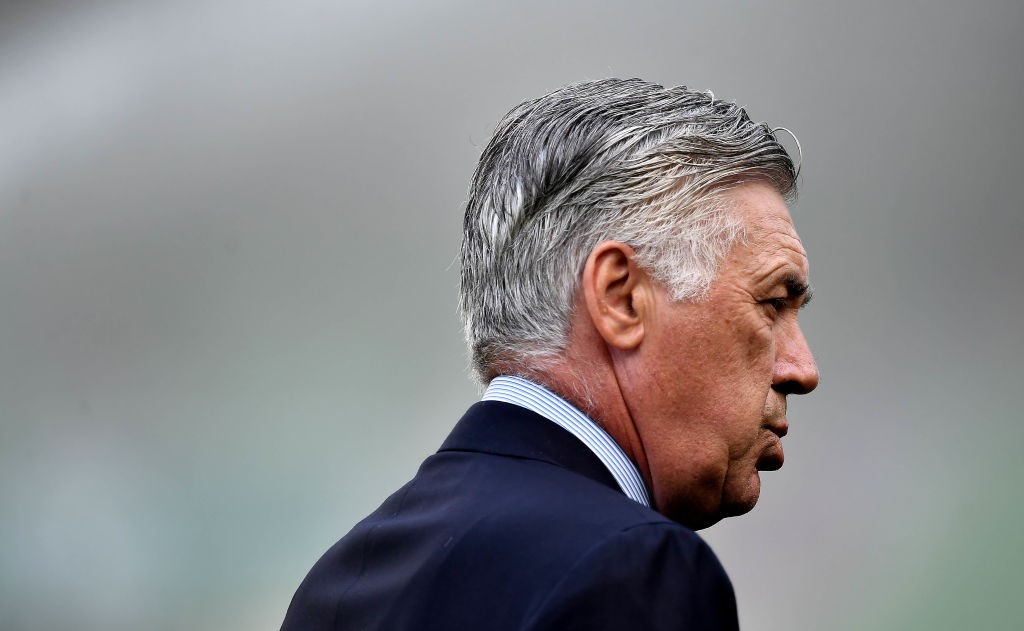Saiguhan Elancheran provides a detailed tactical analysis of the Serie A game that finished Juventus 1-0 Inter Milan.
Last week’s football action in the Serie A saw Juventus host Inter at the Juventus Stadium in the Derby d’Italia. Often touted as one of the most interesting games in this part of the world, everyone from the football community expected this game to be a cracker of a match. Both the teams came into the game with brilliant form as Juventus sought to extend their 27 game winning streak at home. On the other hand, Inter had their own record to talk for themselves. Before the game they were on a seven match winning streak in the league.
Both the managers come into the game after overseeing their sides’ brilliant football of late. Pioli in particular as he has won 8 games, drawn one and lost one game in his 10 Serie A games as Inter’s manager after taking over in mid-November.
Line ups

Made using Tactical Pad
Juventus(4-2-3-1): Buffon // Lichtsteiner – Bonucci – Chiellini – Sandro // Pjanic – Khedira // Cuadrado – Dybala – Mandzukic // Higuain
Inter(3-4-2-1): Handanovic // Murillo – Medel – Miranda // Candreva – Gagliardini – Brozovic – D’Ambrosio // Mario – Perisic // Icardi
Juventus’ tactical approach
The current system is something that was born out of necessity and it has to be tested to know its success. Allegri named a super attacking XI in the game against Lazio and their system was none other than the 4-2-3-1. The new formation worked wonders for his team as he has been able to avoid the defensive flaws that came up in the 3-5-2. They were often beaten in the flanks as teams attacked them with pace and aggression in that zone. Inter, Genoa, AC Milan and Fiorentina have exploited the weakness in the 3-5-2 system.
In the 4-2-3-1 Allegri can name a very attacking side as he can play Cuadrado, Dybala, Pjanic, Mandzukic and Higuain at the same time. In the game against Inter, Allegri did the same when he fielded the above mentioned players in the same team and it was an unchanged side which won 2-0 against Sassuolo.
Inter’s tactical approach
The fans and followers of Inter were surprised to see their team shaped up in a 3-4-2-1 formation against Juventus. The decision was quite shocking as their previous 4-2-3-1 gave them brilliant results and that is one of the reasons why they were in the seven match winning streak in the league. Inter’s back three constituted of Murillo, Medel and Miranda. Medel being the central defensive midfielder in most occasions played as the central defender this time. Their team also consisted of one of their hottest prospects – Gagliardini. Perisic and Jose Mario started behind their talisman Icardi as D’Ambrosio and Candreva played as the wide midfielders.
Inter’s left sided dynamics and Juventus’ counter measures
Right from the start of the game, Inter were aggressive and pressed Juventus from the front. Inter’s initial play in the game was to take the ball to the left flank and knock it into the centre to find the forward players. As Juventus played a lone striker in Higuain, one of the three centre backs could move upfront in support of the attack. And in most of the cases, it was Miranda who moved upfront to create the numerical advantage in the left wing.
The above instance shows the Inter overload in the left wing. Perisic/D’Ambrosio often hugged the touchline as Brozovic and Miranda would come in for support. These movements proved very important for Inter as they often won the battle in the wing. Since Juve have adopted a 2-man central defense, the right back as well as the central defensive midfielder(Khedira/Pjanic) has to come to their aid. And as that has been said, it should be noted that Lichtsteiner has more defensive duties when compared to their 3-5-2 system where Barzagli would slot into the area along with him to help his case. But what happened in these creations had highly favoured Inter. In the above instance we can see Lichtsteiner, Khedira and Cuadrado have come to stop Perisic who has D’Ambrosio, Brozovic and Miranda in support. In their latest run of 7 games winning streak, Brozovic has been the fulcrum of the team.
For Brozovic to come regularly into this area is what Pioli would’ve wanted. The reason being Juventus often play through their wings and Pioli had set the tone that they attack them in the same region. Also one more thing to note is that Lichtsteiner was often caught behind when he went forward with the ball. As we know very well about Juventus’ attacks through the wings, it was no surprise that both Lichtsteiner and Sandro took more touches very high up the field.
In other instances it should be noted that the goalkeeper as well as the central defenders played long balls to D’Ambrosio and Perisic in the left flank. Their movements of the forwards were based on the play in the wings as Perisic or D’Ambrosio often tried to bypass Lichtsteiner and Bonucci and play crosses to Icardi and Mario who were in the box. But Juventus were equally smart enough to reduce the damage caused by their defensive disadvantage in their right flank when they were able to outnumber them in certain situations.
In the above situation, D’Ambrosio is in a tussle with Cuadrado and his options are being either intercepted or marked. The only option for him is to take the ball back and play it to Perisic behind him around his marker but there is also a case that the ball may run out of play. That is exactly what happened and Juventus were able to nullify certain situations like these.
The marking duties also proved fatal to win situations in the area as D’Ambrosio was often able to overpower Cuadrado. Both Brozovic and D’Ambrosio often joined in the left flank whenever Cuadrado collected the ball. These movements created 2v1 situations as Cuadrado would be the farthest player in the wing and for him to gain support, he has to turn back and wait for Lichtsteiner or Khedira/Pjanic. But in the meantime the Inter defenders would press the winger to win the ball and play it to Perisic or Icardi.
The above image reflects the same wherein a direct slow pass is played to Cuadrado by Bonucci. He tries to control the ball till he gets in support as his only other option is to run forward with sheer pace. By the time he waits for his teammates to make a move towards him, D’Ambrosio presses him and gets the ball back. Cuadrado cannot move back as he will then directly face either Brozovic or Perisic. He finds him in a 3v1 situation which will eventually allow Inter to get the ball back. This happened as Brozovic wins the ball only for Perisic to carry the ball and play a lazy pass.
In other cases, Miranda and D’Ambrosio combined together to set up Perisic to release a cross to the centre. The first line of attack would start with Miranda who would find the unmarked D’Ambrosio. D’Ambrosio himself would cross it to the centre to find Icardi in the centre or on most occasions the next line of attack would pass on to Perisic in the same line of play who would in turn play the long ball. These situations involved the players lying very close to the touch line. The wide midfielders ensured that they stayed very wide as Juventus couldn’t afford to play wide because they had to maintain their compactness in the centre. They had to do this as Inter often made Mario and Perisic track back to the centre when they didn’t attack wide. This meant that Juventus had 3 central players compared to Inter’s 4.
The above instance from the 28th minute shows the case where Miranda drives forward and plays a pass to D’Ambrosio who tucks it past Lichtsteiner to find Perisic behind the last line of defence. Perisic collects the ball and plays a deep cross into the box which is headed towards Buffon.
Juventus’ wing orientations
The main way by which Juventus posed many number of threats was through their wings. They were quite brilliant attacking-wise from both the wings but there were differences in which they were set up. In the right wing Cuadrado proved to be the outlet with his pace running past opponents. Often he along with Lichtsteiner created havoc for Miranda. The risk of playing a back 3 was exposed badly as either Brozovic or D’Ambrosio had to come back to support Miranda but they failed in certain occasions. When pressing Juventus high up the field, both D’Ambrosio and Brozovic would be involved in the attacking or middle third and Miranda would be the only defender at the back in that half-space. During a counter or a break, Brozovic and D’Ambrosio could not fall back immediately exposing Miranda against Cuadrado and Lichtsteiner. On most occasions Cuadrado created 1v1 situations against Miranda and was able to successfully stifle him with his pace.
The above instance shows the same. A break in attack and the ball falls at the feet of Chiellini. He passes it to Khedira who glides it to Pjanic. Pjanic plays a delightful ball to Cuadrado in free space and he first runs past Brozovic who comes into the right back position. By this time Miranda reaches the centre and Lichtsteiner runs past Cuadrado and finds space behind D’Ambrosio who covered the distance. Now Cuadrado opens up for Lichtsteiner and he uses his brilliance to dribble past the right wing back and plays a cross into the box which then becomes the first good chance of the game.
In most of the instances, Cuadrado who formed the attacking trident behind Higuain dropped back when Lichtsteiner would play further forward because this allowed Cuadrado to help in the attack. The pace of Cuadrado was well used from the back as he carried the ball from the defensive third during the first phase of build-up and played it to Lichtsteiner who was upfront or played a diagonal ball to the other flank.
The above instance from the 3rd minute is an example for many other instances in which Cuadrado dropped deeper to collect the ball from the back and carry it forward. Cuadrado played as an inverted winger in the right flank when he often dribbled inside from the wings. His position on the wide areas would be usually taken up by Dybala. In this particular instance, Dybala gets the ball from Cuadrado and he moves out wide. This movement draws Miranda from his position and the ball is passed to Lichtsteiner. But due to Inter’s quick closing down, the right back had to play the ball back to Cuadrado to recycle the possession.
On the left flank the strategy slightly varied as Mandzukic who played wide on the other flank is not as fluid as Cuadrado. Here Sandro played the role of an outlet as he burst with pace where Mandzukic played as the more defensive forward.

Graphic courtesy whoscored.com
The above two images shows the heat map of Sandro(top) and Mandzukic(bottom). We can see the forward role played by Sandro when compared to Mandzukic. This meant that Sandro proved to be the ball carrier in most occasions.
Also when Juventus were in the defensive phase, they defended in two banks of four. They defended in a 4-4-2 which was very narrow and compact. Both Khedira and Pjanic are not known for their defensive traits when compared to the likes of Sturaro and Marchisio and hence the onus was on Allegri to reduce the defensive burden on the double pivot. Both Cuadrado and Mandzukic would fall back to aid them and so did Dybala. Dybala falls back and slots in behind Higuain which forms a 4-4-2/4-4-1-1. This works in a way the wingers and the forwards press the opposition in their initial phase of build up and hence help out the weak link in the middle.
Mandzukic the key
In many games fans often remember the ones who score the goals and provide the assists while forgetting other important contributions. Such was the case of Mandzukic. He played brilliantly for Juventus as he turned out to be one of the key figures of the team. Mandzukic offers the team a lot in terms of off the ball movement, occupying spaces, holding off defenders, drawing out defenders as well as defending. He is usually played as a second striker often in a 3-5-2 or in a 4-3-1-2 but now he plays on the left wing.
As now he is found the left flank, the right back will defend him. His new position created problems in the defense as confusions circled the center back whether to follow him or not. Given that Candreva is known for his attacking ability rather than his defensive discipline, Mandzukic often ousted him and created play from the flank along with Sandro. This created 2v1s in the attacking third as Murillo was caught out. In fact, the new position of Mandzukic is one of the main reasons why Pioli had opted for a back three. His physicality is the reason why Poili had to play Murillo on the right flank to counter him.
The above picture shows why Mandzukic offers lot in terms of work rate in the left flank and why he is one of the key figures to enable this formation to play.
Conclusion
The game had a lot to offer for the fans in terms of entertainment. A typical Italian Derby clash in which both the teams showed a lot in terms of energy and intent rather than the goals scored. Much should be said of Inter’s high press and Juventus’ counters as the game did not disappoint the neutrals. Both the teams changed their shapes as the game reached its final minutes. Dybala moved to the left when Marchisio replaced Cuadrado as Pjanic moved further forward to sit only behind Higuain. Inter preferred fresh legs in direct substitutions of Kondogbia and Eder to grind out something from the game. And after all the trials and errors, a brilliant individual goal from Cuadrado at the end of the first half settled the fate of the match. The result meant that Inter’s seven match winning streak came to an end. On the other hand, Juventus extended their home form to 28 continuous wins with aplomb.
Read all our tactical analyses here


































































